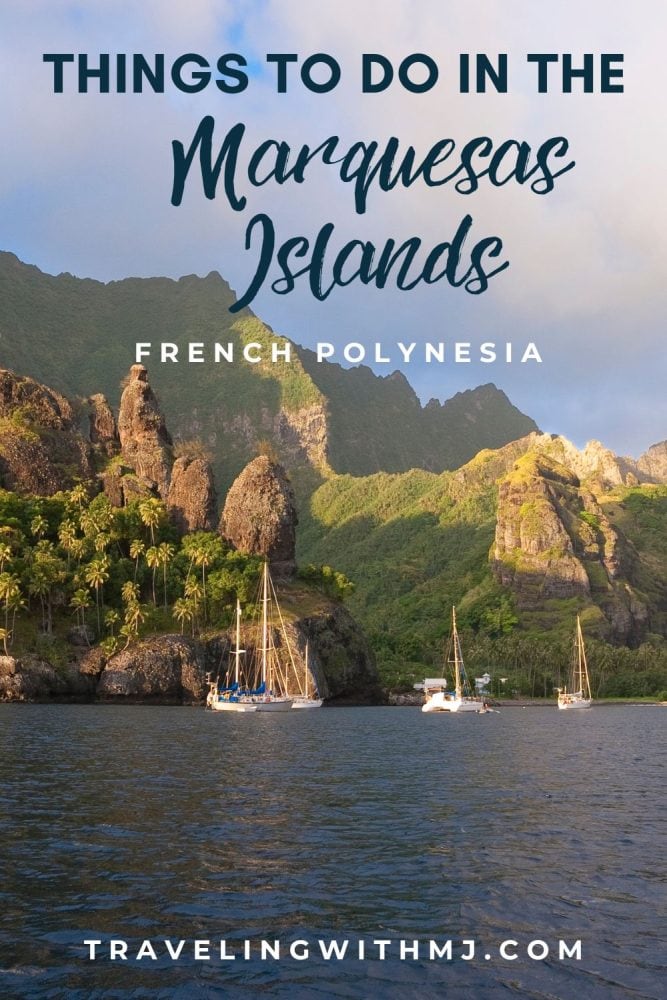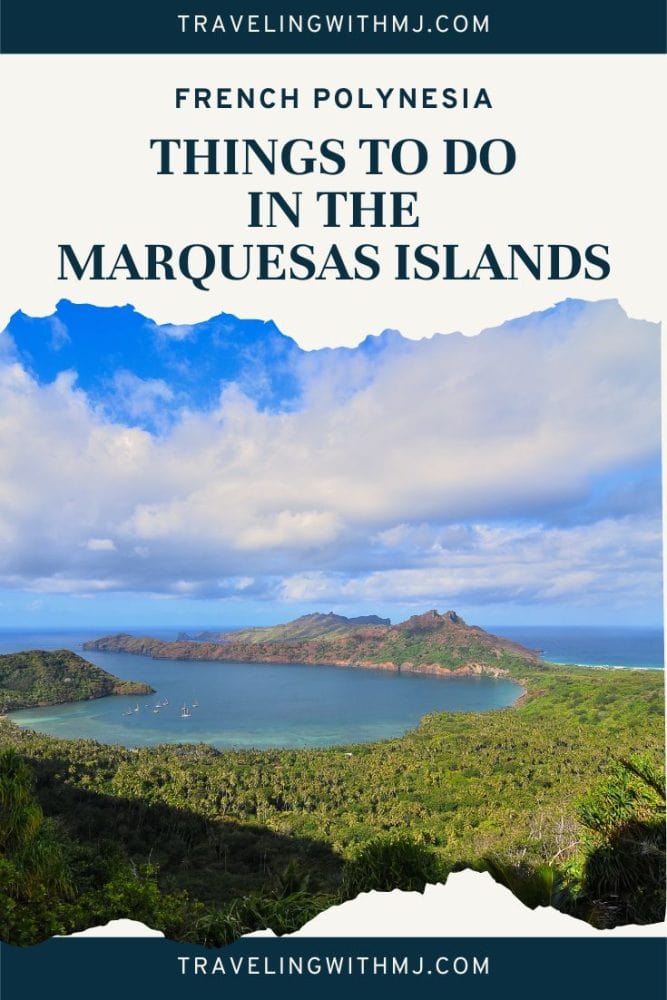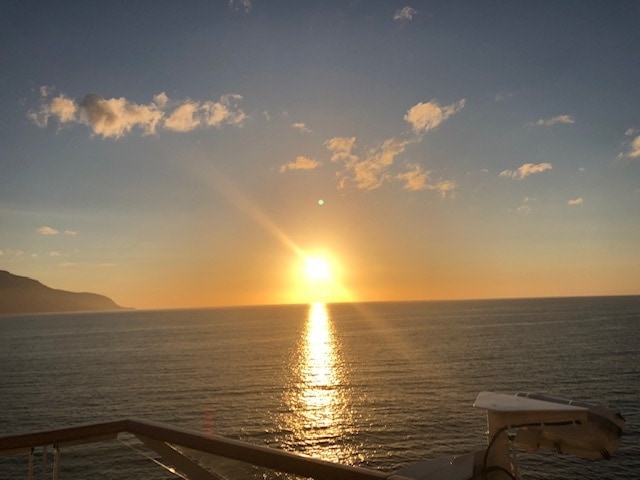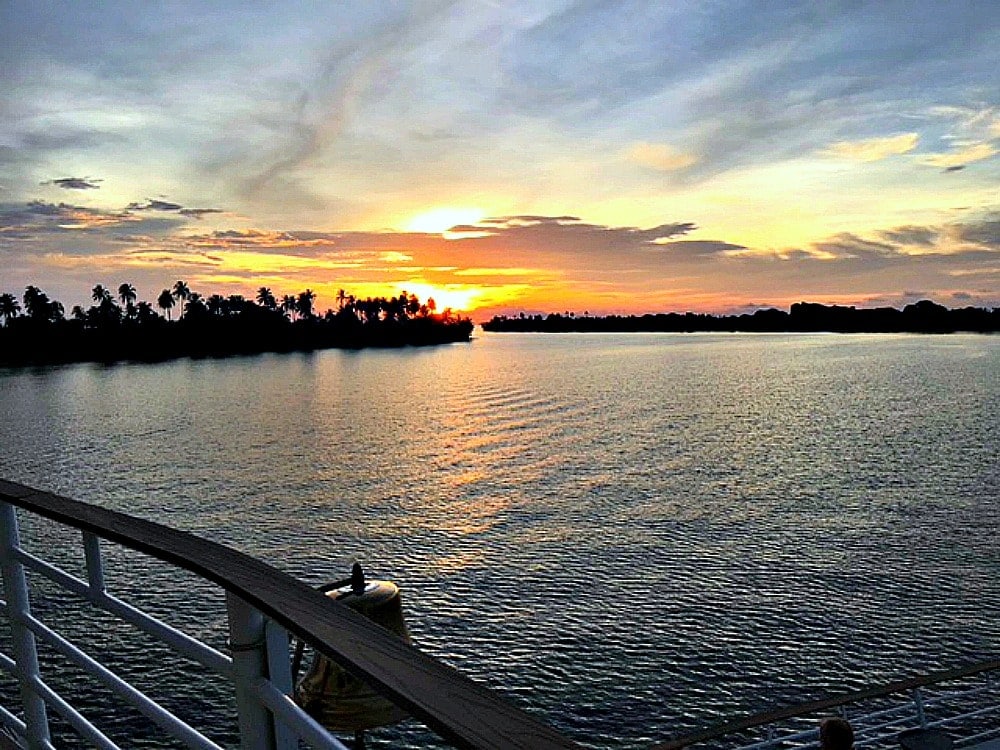Located in the Pacific Ocean, the Marquesas Islands are known for their natural beauty and island culture. Part of French Polynesia, this volcanic archipelago is located 932 miles northeast of Tahiti, and 2400 miles southeast of Hawaii, seemingly in the middle of nowhere. With 12 main islands covered with cliffs, forests, and hidden waterfalls, the Marquesas are one of the most remote spots on earth.
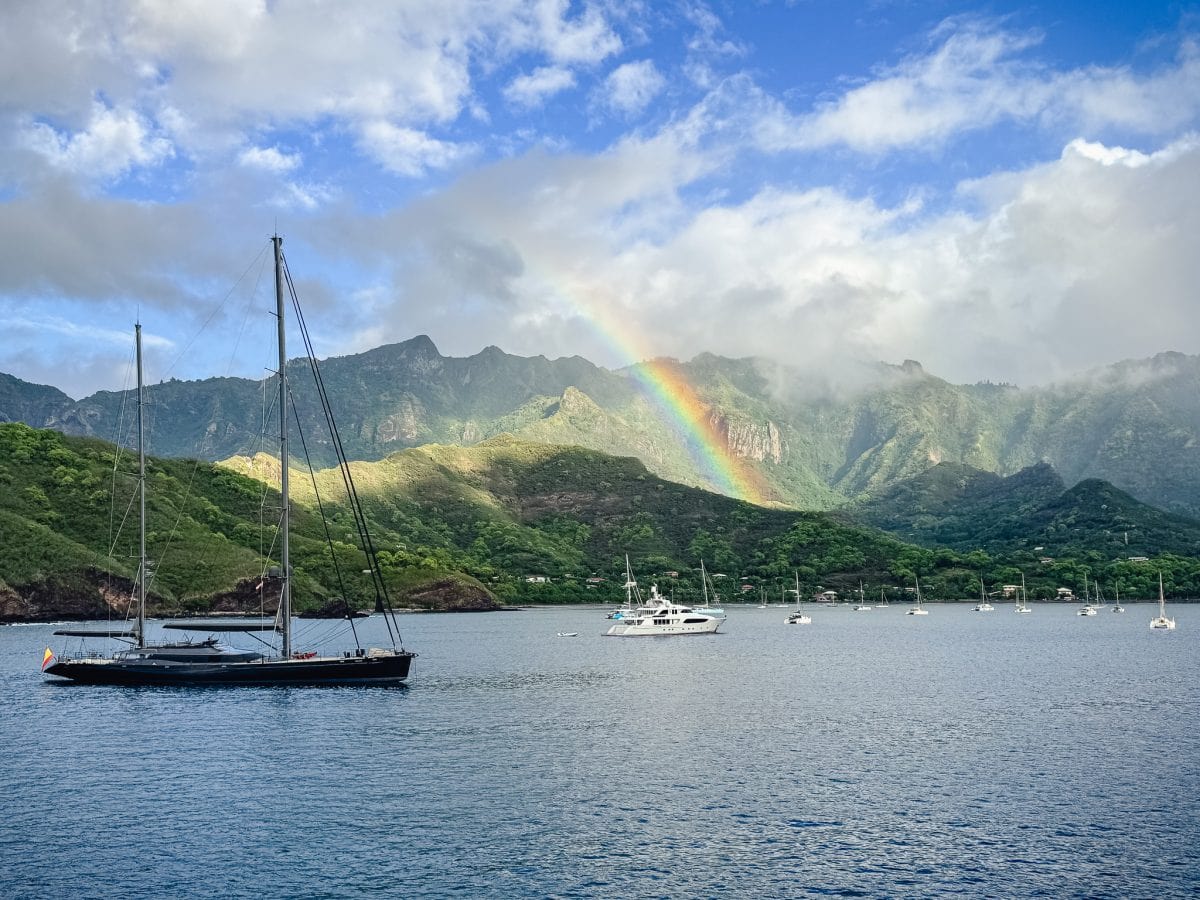
Visitors to the Marquesas have the opportunity to immerse themselves in Polynesian culture, discover ancient traditions, and go on adventures from hiking trails to diving into underwater caves and exploring marine life. The Marquesas Islands provide an opportunity to experience the beauty of nature, culture, and adventure.
When visiting the Marquesas Islands, it’s important to practice responsible tourism practices as conservators of this beautiful paradise. By doing so, we contribute to the preservation of both the natural environment and the island communities that live here.
Where Are the Marquesas?
The Marquesas Islands are located around 932 miles northeast of Tahiti and are made up of 15 islands. While some islands remain uninhabited, others, like the island of Nuku Hiva (you’ll also see it referred to as Nuka Hiva) and Hiva Oa, are centers of Polynesian culture.
Accessing this remote paradise is primarily through flights from Tahiti (about three and a half hours), the main gateway to the region, or finding one of the very limited cruise itineraries that include the Marquesas. Either choice is a long journey, this isn’t a quick day trip from anywhere.
Despite the effort required to reach these remote shores, the journey to the Marquesas is well worth it. Not only is it an adventure into one of the world’s most remote natural environments, but will bestow you with bragging rights among your most well traveled friends.
The Marquesas weren’t on our travel planning list. I knew about them – only a little bit, if I’m completely honest – but when our Tahiti cruise had to zigzag to avoid a cyclone looming in the Society Islands, the Marquesas became part of our revised Windstar Tahiti itinerary. I’ll have more to say about the cruise experience in an upcoming post.
Rich French Polynesian History
The Marquesas’ history, formed by centuries of Polynesian tradition, likely dates back to as early as 300 AD. To reach these remote shores, early Polynesian settlers traveled the Pacific Ocean, establishing a separate culture known for complex social structures and artistic achievements.
European contact in the 16th and 18th centuries brought changes, including the introduction of Christianity and French colonization, which impacted Marquesan society. These changes threatened island traditions, health, and culture. Rumors of cannibalism persisted, despite no evidence to support the claim, and you get whiffs of that rumor to this day.
Ultimately, the Marquesans became known for their warrior culture and artistic heritage, as seen in their tiki statues and tattooing traditions, which continue to inspire fascination and admiration. Their remote location has helped them create an lasting legacy of indigenous culture.
Vibrant Culture
Culture in the Marquesas highlights a variety of traditions and languages. Upon setting foot on the islands, we immediately found that Marquesan was the primary language, with a small bit of French and Tahitian. English is not widely spoken here, although we did have an English-speaking local guide. As we explored on our own, which included a stop at a local grocery store, we managed to get by with some rudimentary French expressions and a lot of pointing.
Tattooing is a centuries-old activity that is central to Marquesan culture. Each designed tattoo tells a story, symbolizing aspects of ancestry, spirituality, and personal journey. Most adults had multiple tattoos, many elaborate works of art. I often wished i knew the story behind them.
The lively rhythm of life in the Marquesas can be felt in the beat of drums and the swing of hips in dance performances. These shows, accompanied by the ukulele’s lyrical songs, honor the islanders’ connection to their land, ancestors, and the natural world. We had several opportunities to enjoy Marquesan music and dance, both on the island and with a performance on our ship. It’s incredible storytelling.
While you’re here, immerse yourself in the diverse Marquesan festivals, which bring ancient traditions to life. Witness the art of tapa cloth making, a skill passed down through generations, as artists skillfully weave tales of folklore and myth into their creations. For the adventurous spirit, the Marquesan marathon offers an opportunity to travel the island’s terrain while soaking in views and the spirit of camaraderie. And if you can time it just right, you can catch the Marquesas Arts Festival. Held every four years, the festival rotates among the most populated islands (Ua Pou, Nuku Hiva, and Hiva Oa) and mini-festivals are held every year on the smaller islands of Tahuata, Fatu Hiva, and Ua Huka. This results in a biennial celebration of the arts.
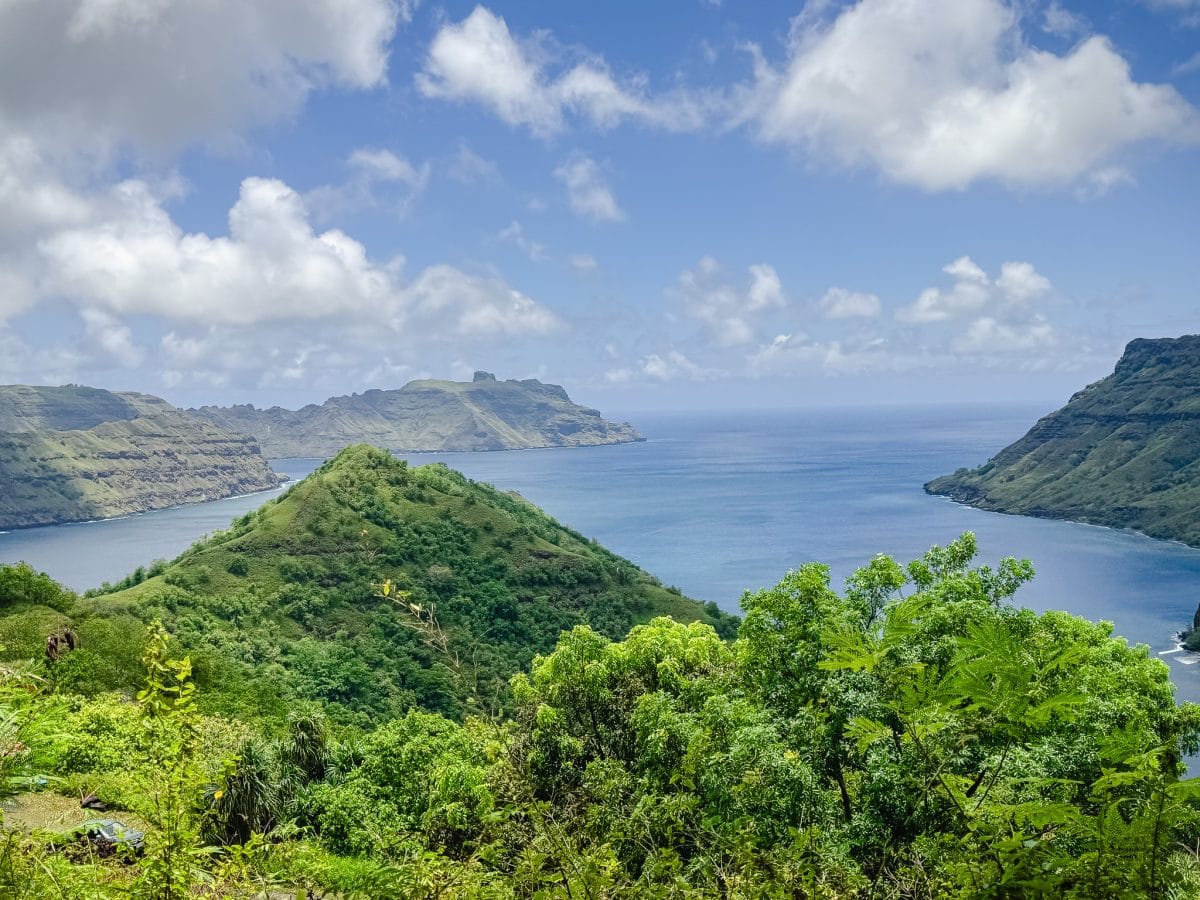
As visitors, we approached the Marquesan culture with sensitivity and respect, embracing local customs with an open heart as we sought to learn and understand the deep-rooted island traditions. During our three days in the islands, we got just a taste of island life, something we would not have experienced had it not be for a cyclone.
By practicing responsible tourism, we ensure that our presence uplifts rather than disrupts the balance of island life, supports local economies, and preserves cultural heritage.
Developing Economy
The economy of the Marquesas Islands is sustained primarily by agriculture, fishing, and tourism. Agriculture is the primary source of income for islanders, with products such as taro, copra (dried coconut kernels), along with a variety of tropical fruits. The waters surrounding the islands provide sustenance through fishing, supporting both local consumption and community needs.
Tourism, although still developing, is emerging as an economic contributor. While offering visitors insight into Marquesan culture and the islands’ natural beauty, sustainability initiatives are equally important. This delicate balance not only preserves the environment and cultural heritage of the islands, but ensures a livelihood for future generations in these beautiful islands.
Local artists rely mainly on handicrafts such as wood carvings, tapa cloth, and shell jewelry to support their livelihood. These traditional crafts not only showcase the talent and creativity of the Marquesan people, but also provide meaningful economic opportunities that support communities across all of the islands. By supporting local businesses and purchasing handmade goods, visitors can directly contribute to the prosperity of Marquesan communities.
Things to Do in the Marquesas Islands
Small and remote, the often sleepy Marquesas Islands still offer a variety of activities for visitors. Not surprisingly, most of these center around water activities, but there are still things to see when you need to come out of thew water for awhile.
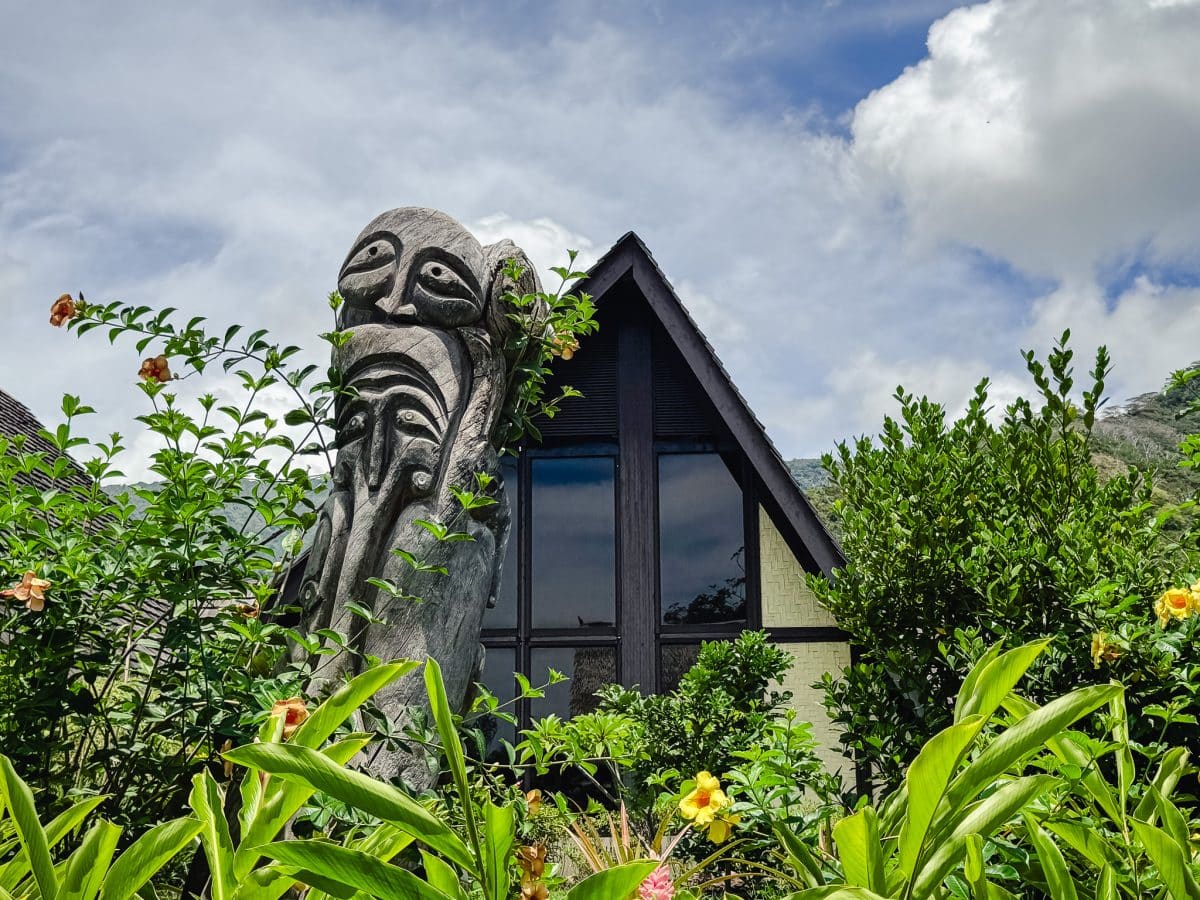
Here are a few suggestions of things to do in the Marquesas Islands.
1. Hiking Adventures: Hikes will take you through lush valleys up volcanic peaks, along ancient trails that go through dense forests, revealing hidden waterfalls, sacred sites, and panoramic views of the surrounding landscapes. If it feels eerily familiar, the fourth season of Survivor (2001) was filmed there. I’d recommend finding a local guide, booking an excursion if you’re on a cruise, or finding a good website with maps and information. Popular trails include Fatu Hiva Road – Omoa to Hanavave (Omoa), Atuona Valley (Atuona), Hatihe’u – Anaho Beach (Hatihe’u), Taiohae Bay (Taiohae), and Smiling Tikis (Tepuna).
2. Underwater Exploration: Dive into the crystal-clear waters surrounding the Marquesas Islands and discover an underwater world filled with life. Underwater caves, coral reefs, and the surrounding areas are home to stingrays, electra dolphins, and scalloped hammerhead sharks. Snorkel among diverse marine ecosystems, encountering a variety of marine species, including tropical fish and sea turtles. The only dive center is the islands is on Hiva Oa.
If you’re like me – a water lover who is not a great swimmer – the warm, clear water will entice you to enjoy just being in the water, even if you don’t want to go much below the surface.
3. Beach Bliss: The Marquesas boasts beaches where you can soak up the sun, swim, and watch sunsets (or sunrises). Relax and unwind on the beaches lining the coastline. We discovered a black sand beach not too far from where our ship tendered, and quite happily spent time in the water and walking along the shore. We didn’t spend time exploring the various beaches, but for visitors in the islands for longer than on a cruise, it may be worth mapping them out. One beach that continually came up in our research was Hanatekuua Beach on Hiva Oa. It’s a 2-hour hike to get there, but we’re told it’s a beautiful spot for swimming and snorkeling once you get there. Of course, it’s a 2-hour hike back out, too. The beach can also be accessed by boat.
4. Kayaking Sightseeing: Paddle through bays and explore hidden coves located along the coastline. Kayaking offers an immersive way to experience the beauty of the Marquesas Islands up close, allowing you to explore pristine waters and discover secluded beaches difficult to access by land. There is a water sports center on Nuku Hiva, you’re best bet if you need equipment. Cruise ships likely have gear and equipment onboard. Caution, though, the waves can often be challenging here. As a novice kayaker, I’d likely only go out in a protected bay where I’d feel comfortable with my skill level. If you clock in at an expert level, you’d likely enjoy open sea kayaking.
5. Cultural Activities: Immerse yourself in the Marquesan culture by participating in local festivals and cultural demonstrations. Witness traditional dances, music performances, and look at handcrafted goods to learn more about the islands’ history and customs. Engage with locals, learn about their way of life, and build connections that overcome language barrier. A smile goes a long way to connecting with people.
There are a few museums in the Marquesas.
The Gauguin Museum pay tribute to the famous painter and his time on Hiva Oa. Paul Gauguin moved from Tahiti to Atuona (on Hiva Oa) from 1901 until his death in 1903, becoming reclusive in the last years of his life. There is no original artwork here, much of the museum is open air and not protected from humidity, but plenty of reproductions give a look at his time in the islands. The surrounding grounds are worth a stroll as well.
Espace Jacques Brel, also on Hiva Oa and near the Gauguin museum, is a aviation museum located behind the cemetery where the graves of Belgian singer Jacques Brel and painter Paul Gauguin are located. It summarizes Brel’s three years on the island with panels about his life. The center piece is Jacques Brel’s plane, a Beechcraft Bonanza named Jojo, that he used to get to the islands.
Musee Communal de Ua Huka is located on the smallest of the northern islands. There are four different outdoor museums, each with a specific focus and dedication – wood, petroglyphs, sea, and everyday. It has outgrown its space and is being relocated to a site in Tetumu.
6. Winged Splendor: Given its remote location, I was surprised to learn that the Marquesas are home to numerous endemic bird species. That is, they can only be found in the Marquesas. From the vivid blue plumage of the pihiti (ultramarine lorikeet0 to the brilliant yellow and black plumage of the Marquesan honeyeater, visiting the islands is high on the bucket list for serious birders.
What to Eat in the Marquesas
Indulge your taste buds in the mouth-watering flavors of Marquesan cuisine with fresh, locally sourced ingredients. Fish and fruit are the obvious choices – Try the tuna, mahi mahi, and grouper, along with pineapple, breadfruit, and taro.
A few specialty dishes worth a try.
- Poisson Cru – raw fish marinated in lime juice and coconut milk. I thought it was similar to ceviche.
- Umu – a traditional way of cooking, more than a specific dish. An earth oven of volcanic stones, with food places on top. Typically umu dishes include fish, vegetables, and chicken. Coconut cream is used instead of oil, adding a hint of sweetness to the smoky goodness.
- Pain Po’e – a traditional Tahitian dessert made from ripe bananas, pumpkin or sweet potato, and coconut. It’s all wrapped up in banana leaves and baked until tender.
- Tamaaraa – Another Tahitian dessert, typically made with grated taro mixed with coconut cream, sugar, and sometimes vanilla. It, too, is wrapped in banana leaves and baked.
Getting to the Marquesas Islands
While our visit to the Marquesas were not planned, most visitors will need to make specific plans. There are currently three ways to get to the islands.
By air – Air Tahiti operates weekly flights to the Marquesas from Papeete, Tahiti. Fight time is three hours and 20 minutes (3:20). Flights between Nuku Hiva (NHV) and fHiva Oa (AUQ) are 50 minutes. For the well-heeled, private air charters are also an option.
By sea – Cruise ships stop in the Marquesas as part of a French Polynesia itinerary, usually operated out of Tahiti. Passenger ferries also operate between the islands. Also coming out of Tahiti is the Aranui 5, a half-cargo/half-cruise ship that makes about 15 trips a year and delivers goods to the islands.
Where to Stay in the Marquesas Islands
There is one upscale resorts in the Marquesas, Le Nuku Hiva by Pearl Resorts (a Relais & Chateaux property). It books up quickly, even with prices starting around $700/night.
Mostly likely you’ll be looking for a small guesthouse or inn. Start you search here.
Know Before You Go
Currency: The currency in the Marquesas, and throughout all of French Polynesia, is the French Pacific Franc. U.S. dollars are also widely accepted, and in many shops, prices are listed in both currencies. Credit cards seemed less widely accepted.
Electricity: The Marquesas use Type C plug-ins, so you’ll need an adaptor. Type C has two round prongs, and is most likely the adaptor you’ve used when traveling in Europe. Standard voltage is 220V.
Time Zone: The islands are in the MART time zone, UTC-9:30 (a half hour difference between the main hubs in Tahiti, Bora Bora, and Moorea). That means when it’s 5 pm here in Seattle, it’s 2:30 pm in the Marquesas.
Safety: The islands have a low crime rate, and crimes against visitors is nearly unheard of. Use commonsense precautions when traveling in remote areas, as you’re more likely to run into trouble by not being prepared with water, sun protection, and adequate gear.
Religion: Catholicism is the dominant religion, although many locals maintain their traditional beliefs and customs.
Language: Marquesan, French.
Getting Around: You can rent a car in the islands, but it’s expensive. it’s easier to book transportation with a local residents. Islanders offer taxi-like services and act as tour guides around the island in open-air 4×4 jeeps. Your hotel or guesthouse can help set this up.
Medical Information: Remote destinations mean few medical facilities, and emergency care may be difficult. Take precautions against mosquito bites (long sleeves and pants recommended, use repellent, and sleep under netting if camping). There is a hospital on Nuku Hiva, and a medical center on Ua-Pou. Medical and evacuation insurance is strongly advised.
Visitor Requirements: No tourist visa is required for U.S. citizens. Citizens from other countries may require one. Check with your local government entities for further information. Your passport must be valid for at least three months before your planned departure date. Again, check with the state department for any changes.
Climate: Most of the archipelago experiences a tropical rainforest climate, with precipitation all year round. Most of the rain falls during the summer. It’s northerly location means very low risk of tropical storms and hurricanes. Remember, the Marquesas fall below the equator, so seasons will be different. We visited in February and the temperature was warm – mid-high 70s – but we did have at least some rain every day we were there, and fairly heavy rain on one of the days.
Emergency Numbers: It’s always helpful to keep these handy. Fire and emergency: 18. Police: 17. Ambulance and medical assistance: 15. Hopefully, you’ll never need these.
Holidays: During public holidays and special observances, some businesses and public offices may be closed or operate on reduced hours. Plan accordingly, and if you’re fortunate, perhaps you can participate in a local celebrations to experience the rich cultural diversity and warm hospitality of the Marquesan people.
They include: New Year’s Day, Gospel Day (March 5th), Good Friday, Easter, Easter Monday, International Workers’ Day (May 1), Victory Day (May 8th), Ascension Day, Pentecost, Whit Monday, Autonomy Day (June 29th), Assumption Day (August 15th), all Saints’ day (November 1st), Armistice Day (November 11th), and Christmas Day.
For Pinterest
Save to your favorite Pinterest boards and start planning for your trip to the the Marquesas Islands
